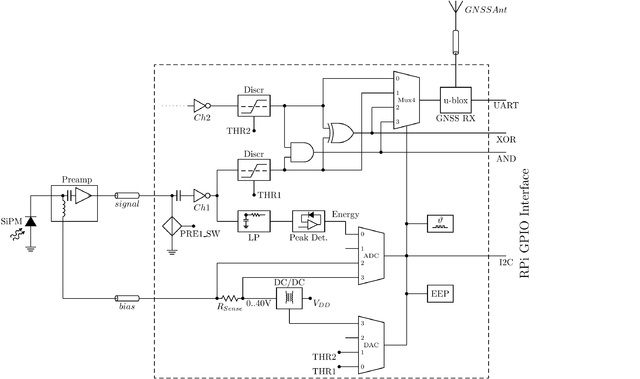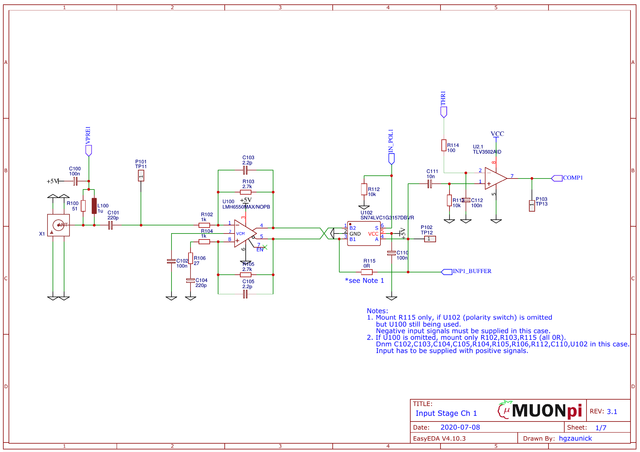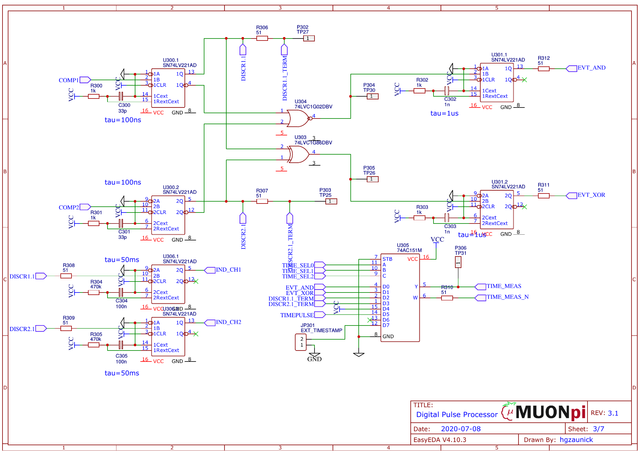Difference between revisions of "Muonpi board"
| Line 27: | Line 27: | ||
=== Digital Pulse Processor === | === Digital Pulse Processor === | ||
| − | The outputs of comparator U2 are time-shaped with monostable gate U300 to 100 ns wide pulses. These are indicated as discriminator outputs for both channels. They are logically connected with the AND gate U304 (which is actually a NOR gate but with the inverted inputs acting as an AND) as well as a XOR gate U303. These signals are shaped to 1us pulse length and supplied to GPIO pins (EVT_XOR and EVT_AND). The discriminator signals are also time-shaped to ca. | + | The outputs of comparator U2 are time-shaped with monostable gate U300 to 100 ns wide pulses. These are indicated as discriminator outputs for both channels. They are logically connected with the AND gate U304 (which is actually a NOR gate but with the inverted inputs acting as an AND) as well as a XOR gate U303. These signals are shaped to 1us pulse length and supplied to GPIO pins (EVT_XOR and EVT_AND). The discriminator signals are also time-shaped to ca. 100 ms length by U306 to drive the indicator LEDs for a discernible visual signal. With the multiplexer U305 (74AC151), one of the signals (EVT_AND, EVT_XOR, DISCR1, DISCR2, TIMEPULSE) connected to its inputs can be selected and fed to the output TIME_MEAS. The selection word is supplied by the I2C-expander U404 (PCF9536). The selected output is routed to the interrupt pin of the u-Blox NEO GNSS chip where the rising edge is timestamped with nanosecond resolution and sent as UBX message TIM-TM2 over the UART interface to the host. The discriminator signals, time-shaped logic gates and the inverted multiplexer output are all series terminated in order to avoid false triggering or wrong timing due to reflections whereas the non-inverted multiplexer output driving only the u-Blox interrupt pin is terminated with a Thevenin matching network at the end (see GNSS receiver). |
[[File:Digital-pulse processor v3.1.png|thumb|640px|Digital pulse processor (V3.1)]] | [[File:Digital-pulse processor v3.1.png|thumb|640px|Digital pulse processor (V3.1)]] | ||
Revision as of 00:39, 2 December 2020
The MuonPi board is designed as plug-on board for the Raspberry Pi B+ in a form factor conforming with the RPi HAT specifications.
Contents
Functional Description
The MuonPi board implements following functionalities:
- Two input channels
- Supply voltage for remote powering the preamplifier through the signal line: The voltage can be switched on/off through a GPIO signal (individually for the two channels). It includes overcurrent and overtemperature shutdown and a fault signal.
- Bias voltage supply for the SiPM sensor and bias voltage/current supervision. A DC/DC converter generates the required reverse biasing voltage from the RPi 5V rail. The voltage can be switched on/off through a GPIO signal. Actual bias voltage and current are measured through the on-board ADC. The voltage can be controlled through the on-board DAC (not in HW version 2).
- Optional inverter for the two signal inputs (mounting option) in case negative signals are presented to the board
- Threshold discriminators with adjustable thresholds (DAC channels 1 and 2) in the range from 0.5 mV to 3V. The discriminator outputs are LVCMOS signals with a length of ~100 ns.
- Both channels are logically connected by one AND gate and one XOR gate. In this way, a coincidence ("both at the same time") as well as an anti-coincidence ("only exactly one") within a 100 ns time window can be asserted.
- The two gate signals (AND/XOR) are time-shaped to 1 us length and provided to the GPIO interface of the RPi
- The two discriminator signals and the two logic gate signals are fed to a multiplexer. Its output is fed to the time stamping input of the u-blox GNSS receiver.
- The u-blox GNSS receiver NEO-M8N is utilized to get the precise time and frequency reference in order to provide a sufficient precision of the time stamping on the nanosecond level. The time stamp of an event (leading and trailing edges of the signal present at the multiplexer output) is transmitted to the RPi via UART interface through the UBX-TIM-TM2 message.
Detailed Description
The MuonPi board design is open hardware. It is entirely defined in the free EDA cloud tool EasyEDA. The current working version of the design is HW Ver 3 which is explained in detail below.
The predecessor versions are available for reference: HW Ver 2 and HW Ver 1.
Input Stage
The signal input comprises a 50 Ohms-terminated signal path with simultaneous provision of the bias voltage (VPRE1) for remote powering of the preamplifier. The AC component is decoupled and provided to the differential wide-band amplifier U100/U200 (LMH6550) with a voltage gain of ~3. In this way, the output is symmetrical around a mid-scale common mode voltage with a non-inverted and an inverted signal superimposed. The analog switch U102/U202 (SN74LVC1G3157) selects either one depending on the switch control input (POL1) and presents the capacitively coupled signal to a fast comparator U2 (TLV3502). The threshold THR1 is provided from the DAC U402 (see "RPi Interface").
Digital Pulse Processor
The outputs of comparator U2 are time-shaped with monostable gate U300 to 100 ns wide pulses. These are indicated as discriminator outputs for both channels. They are logically connected with the AND gate U304 (which is actually a NOR gate but with the inverted inputs acting as an AND) as well as a XOR gate U303. These signals are shaped to 1us pulse length and supplied to GPIO pins (EVT_XOR and EVT_AND). The discriminator signals are also time-shaped to ca. 100 ms length by U306 to drive the indicator LEDs for a discernible visual signal. With the multiplexer U305 (74AC151), one of the signals (EVT_AND, EVT_XOR, DISCR1, DISCR2, TIMEPULSE) connected to its inputs can be selected and fed to the output TIME_MEAS. The selection word is supplied by the I2C-expander U404 (PCF9536). The selected output is routed to the interrupt pin of the u-Blox NEO GNSS chip where the rising edge is timestamped with nanosecond resolution and sent as UBX message TIM-TM2 over the UART interface to the host. The discriminator signals, time-shaped logic gates and the inverted multiplexer output are all series terminated in order to avoid false triggering or wrong timing due to reflections whereas the non-inverted multiplexer output driving only the u-Blox interrupt pin is terminated with a Thevenin matching network at the end (see GNSS receiver).


